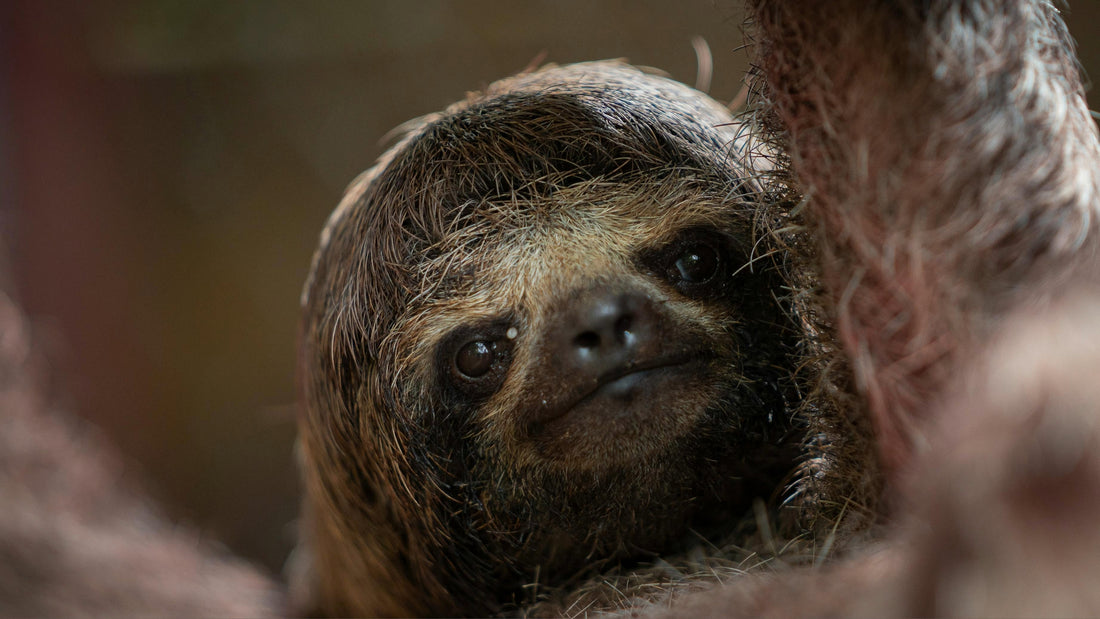Kids are naturally drawn to sloth facts because these amazing creatures spark their curiosity and love for the unexpected. Sloths constantly defy what we might assume; for example, an animal so slow on land is actually an excellent swimmer, and despite moving so little, they possess incredible strength. This creates a delightful paradox for children. There's also a humorous element. While kids are full of energy, they find it amusing to learn about an animal that takes "lazy" to an extreme, offering a funny contrast to their own busy lives. Sloths are commonly thought to be slow, lazy and sleepy. These traits are humorous and perhaps even deeply appealing for exhausted parents juggling work, household responsibilities and raising busy little kids. For kids who want to learn a little more, share these fun facts about sloths that make these animals so unique.

Everything Kids Want to Know About Sloths
Sure, they move slowly, but there is so much more to learn about the life of sloths. Kids are often captivated by sloths because these animals combine inherent cuteness with a host of fascinating, unique characteristics. Their sweet, often smiling faces instantly endear them to children. What truly sparks wonder and amusement is their incredibly slow movement, even for basic tasks like eating or using the restroom. Plus, the fact that sloths spend almost their entire lives hanging upside down— sleeping, eating, mating, and even giving birth in this position— is highly unusual and sparks immense curiosity. They are mysterious, misunderstood animals that have been studied extensively. Reading books about sloths seems perfectly fitting when its time to coax little ones into a nice, deep slumber. In the meantime, here is some fascinating information to share with kids about where sloths live, how they act, what they eat, and more.
Lifespan of Sloths
Accurately determining the lifespan of sloths, particularly in the wild, presents a significant challenge. Their elusive nature makes it incredibly difficult to track them from birth to death, and scientists lack reliable physical indicators for precisely aging adult wild sloths. Despite these hurdles, general knowledge about their lifespan has been gathered through estimations and observations.

(1) Sloths live longer in the wild than in captivity.
How long sloths live is a big mystery. Scientists and wildlife experts have not been able to accurately determine the age of adult sloths. Also, these creatures have never been successfully tracked from birth until death in their natural habitat to assess their average lifespan. The oldest sloth living in captivity has reached 50 years of age, but these mammals likely live longer in a the wild.
(2) The oldest sloth was 54 years old.
A two-toed sloth named Jan passed away in August, 2024 after living in the Krefeld Zoo in Germany for 38 years. Born in the wild in 1969, Jan originally lived in a Hamburg zoo before transferring to his permanent home. Even more remarkable than his age is the fact that Jan produced 22 pups with two different mothers. His final offspring, a girl, was born just a few months before Jan died.

Habitat of Sloths
Sloths, those iconic inhabitants of Central and South American tropical rainforests, thrive in a habitat uniquely defined by their arboreal lifestyle within the rainforest canopy. They predominantly favor undisturbed forests, where the warm, humid conditions are ideal for their survival. To delve deeper into the fascinating world of sloth habitats, continue reading.

(3) Where to observe sloths in their natural environment.
If your family is up for an adventure, there are many places to watch sloths swing from the trees, although it's more likely you will find them sleeping! Here is a list of some good spots to visit in Costa Rica: La Fortuna, Monteverde Cloud Forest Reserve, Bijagua Ranas, and Rincon De La Vieja. You can also find these mammals in these spots of Peru: Tambopata National Reserve and Pacaya-Samiria National Reserve.
(4) They spend the majority of their time in the trees.
The primary reason to hang from high above is to stay safe from predators like jaguars and eagles.They come down occasionally to mate, find more food, or poop (which they do only once a week!)
(5) Cold temperatures are very bad for sloths.
In order to conserve energy, sloths have lost the ability to control fluctuations in their body temperature. As a result, they can experience swings of up to 10 degrees celsius in core body temperature every single day. If outside temperatures drop, microbes in the sloths' stomachs die and they can no longer digest leaves. So, in essence, sloths can die of starvation even when their bellies are full.

Anatomy and Physical Traits of Sloths
Sloth anatomy is truly fascinating, showcasing remarkable extreme specialization for their unique, slow, and upside-down arboreal life. Nearly every part of their body has evolved to support these specific behaviors, making them dramatically different from other mammals. From their internal organs to their fur, every detail of a sloth's anatomy is a brilliant example of evolutionary adaptation, perfectly tuned for their singular, unhurried existence in the trees.

(6) Sloths are not smiling because of happiness.
Sloths are very photogenic since their mouths are permanently set in what appears to be a smile. The truth is that the happy expression is not a reflection of their true state all the time. If sloths are experiencing stress, pain or anxiety, their expression never changes. The coloration and bone structure of their faces makes it look like they are always smiling, often leading people to approach these creatures who prefer to be left alone. Human contact induces great discomfort despite a facial expression that conveys a contrary emotion.
(7) Sloths are strong swimmers.
Sloths are amazing swimmers and much quicker in the water than on land. In fact, they can move through water three times faster than they can run. Sloths' long claws interfere with walking and running, but they are advantageous when swimming. Even more interesting, sloths can hold their breath up to forty minutes. These animals have two additional neck vertebrae than every other mammal, which allows them to easily turn their heads while positioning their noses above the water.
(8) Sloths do not have incisors.
This makes it difficult for them to nibble leaves into small enough bits to chew up and swallow. The animals instead use their extremely firm lips to repeatedly smack the leaves so they eventually break down into little chunks.

(9) Sloths are extremely strong.
Although they have significantly less muscle mass than other mammals, sloths are easily three times stronger than humans. Newborns can hoist themselves over a tree branch with just one arm. They have unique tendons in both their hands and feet that allow them to hang for hours, even when sleeping. This strength is also what protects them from predators. Not even jaguars are able to loosen a sloth's strong grip on a tree branch.
(10) Sloths can turn their heads 270 degrees.
Extra vertebrae in their backs allow sloths to rotate their heads just enough to get a 360 degree view of the world around them. In doing so, sloths can detect the presence of potential predators without ever moving their bodies. This extra vertebrae is part of the anatomical evolution of a sloth, allowing it to survive while expending the smallest amount of energy possible. The additional bone structure also provide more support for the animal's head, which is especially important since they are always hanging upside down.
(11) Sloths fall out of trees without getting hurt.
These funny creatures can easily fall 100 feet without a single bump, bruise, or broken bone. In fact, it is suggested that sloths fall on average about once a week. When two male sloths are fighting over a female for mating purposes, each tries to push the other from the tree. Fortunately, they rebound and quickly climb back up high into branches without suffering.
(12) Sloths used to be the size of elephants.
Millions of years ago, they slowly roamed the earth by foot and pulled down tree branches for food. Today's sloths are relatively small, tree-dwelling animals, but their ancient relatives were absolutely enormous. During the Ice Age, several species of giant ground sloths roamed the Americas. The most famous, Megatherium, could grow to the size of a modern Asian elephant, weighing around 8,000 pounds and standing up to 20 feet tall on its hind legs to browse on tree leaves.

Sloth Diet and Digestion
The sloth's diet and digestion are among the most fascinating aspects of their biology, tightly woven into their famously slow way of life. The sloth's languid pace and unique biology are perfectly explained by their diet of low-nutrient leaves, combined with a super-slow metabolism and a highly specialized digestive system. Truly, every aspect of their eating and digestion is a marvel of energy conservation. It's truly a masterclass in adapting to a challenging food source.

(13) Sloths have slow digestive systems.
The sloth's digestive system is ridiculously slow which is probably not too much of a surprise. They have a multi-component stomach that supports the breakdown of cellulose, a cellular component of their plant-based diet. Scientists have discovered it can take 30 days for sloths to digest a single leaf. The sloths' slow metabolic rate is why they are so sluggish. In the course of an entire day, sloths will not cover more than half a length of a football field.
(14) Sloths help grow avocados.
We have sloths to thank for avocados. Giant sloths, unlike the the smaller versions that swing from the trees, used to roam the earth much like dinosaurs. The enormous size of their digestive system allowed them to swallow avocado seeds whole. They consumed avocados in large quantities and then spread the seeds, fully intact, wherever they roamed.
(15) Sloths have strange pooping habits.
Kids will find it interesting to know that sloths only relieve themselves about once a week, but when they do, it is quite the production. The output weighs about one third of their total body weight every time sloths do the deed. It's a good thing they don't drop these bombs from the trees or creatures below suffer some pretty stinky blows. Rather, sloths dig a hole at the base of a tree and poop into it.

Share More Intriguing Animal Facts With Your Kids
Kids are captivated by sloth and other animal facts for a combination of reasons: their innate curiosity, emotional connections, and the sheer wonder of the natural world. These fascinating details offer an engaging and educational gateway to understanding the world around them, perfectly catering to a child's natural desire for wonder.





